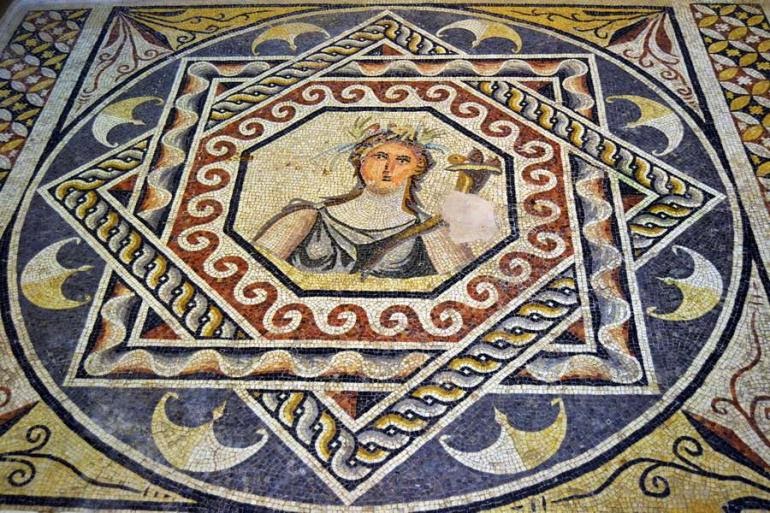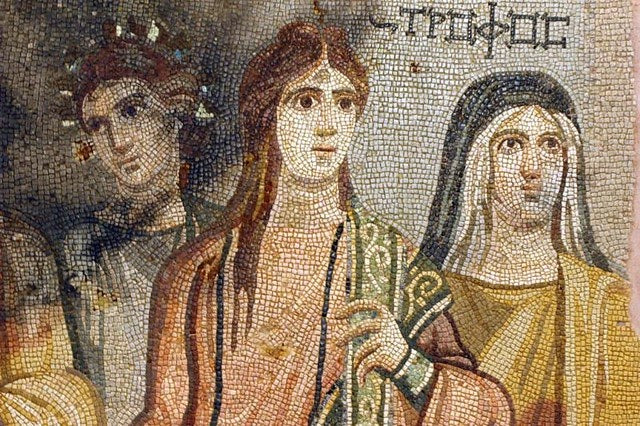The Largest Mosaic Art Museum in Gaziantep

New discoveries of ancient mosaic art continue to fascinate us. As you think about your 2020 mosaic art travel destinations, consider Gaziantep, Turkey. This surprisingly large city of 2 million residents is filled with great cuisine, important history, and is home to the Zeugma Mosaic Art Museum.
The relatively new museum (it opened in 2011) is the largest of its kind in the world. Visitors can wander 90,000 sf of mosaic art, most of which was unknown until after 2000!

Zeugma – Lost In Time?
How did a city on the southern Anatolian plains become such a treasure chest of fine mosaic artifacts? Often, when mosaic art emerges from the depths, the Romans were involved. Indeed, this was the case in the old city of Zeugma. Founded by Alexander the Great’s forces in 300BC, strategically located on the Euphrates River, and a military center, it drew the wealthy: businessmen, generals, and officials. Much like Pompeii, it flourished and flaunted vast villas, market squares, public buildings and plenty of opportunities to decorate them with mosaic designs.
Natural Factors in Play
Earthquakes, general destruction, and disinterest kept the city and its artifacts nearly secret until an upcoming dam project meant that the area would soon be flooded. After much back and forth between archaeologists and looters removing pieces, enough was preserved to begin the museum.

The significance of the finds, beyond their raw beauty, is in the nuances of daily life they preserved. Zeugma was a melting pot of cultures, a spot along the Silk Road, and the pieces were well-preserved.
Extracting the Mosaics
To extract the mosaic designs, archaeologists would first cover them with glue, hammering down a layer of gauze on the thousands of tiny tiles to hold them in place. The mosaic art was then cut up into pieces for transportation to the museum. Now, they await visitors in a protected environment.
Gods of Water and Sea
The finds on display today cover the pantheon of gods, scenes of daily life for wealthy residents, and glimpses of the residents. Aquatic themes were also popular, as one might expect from a port city.

This physical representation of the God of the Euphrates was found at the bottom of an octagonal pool in a villa hallway. Look closely, and you’ll see the river flowing out of the jug he’s resting his elbow upon.
He’s wearing a crown of local tree branches. His clothing looks like the flowing waters of the Euphrates, and the plants to his side would have been found on the local river banks.
The Goddess of Water
The parents of the River God would have been Oceanus and Tethys, and they were also popular in Zeugma mosaic art. Tethys, daughter of Gaia and Uranus, was the goddess of all things water: rain clouds, rivers, springs, and wells. Oceanus, as you might have guessed, was the embodiment of the ocean.

This is an enormous piece, but museum visitors can see the details that indicate the identity of the couple. Tethys bears tiny wings of storm clouds on her brow and Oceanus sprouts crab claws.
Gods of Prosperity and Gaiety
As expected in a city of wealth, the Roman gods of abundance, prosperity, and enjoyment are well represented in the museum.
This stunning mosaic art shows Dionysus, the God of Wine, at his marriage to Ariadne. It was a good pairing for Ariadne, who had been abandoned on an island by the hero Theseus. Fortunately for her, her future husband enjoyed the island as a holiday spot, and here you see the happy results.

Another happy match between Eros, the God of Love, and Psyche, beautiful mortal is celebrated in a large mosaic design. Modern soap operas have much in common with these myths celebrated in Roman art! Handsome Eros, the fairest of the gods, was dispatched by his mother Aphrodite to punish Psyche. Her only fault was having such beauty that she was confused for the Goddess.

Eros, instead, was immediately smitten with the mortal, and they married. Here, they sit side by side, eternally happy.
Demeter, Goddess of Agriculture, was also an appropriate choice for a bustling, prosperous port and market city. Depicted in this mosaic, she wears a crown of flowers and wheat ears. Surrounding her, eight axe blades. This odd choice is believed to refer to the months that her daughter Persephone spent with her each year. The other four, of course, were spent with Hades – causing winter to arrive.

A similar layout was used for this depiction of the nine Muses. The preservation of the colors is quite remarkable. As you can see in the photo of the excavation site, this mosaic art was used to decorate the floor of a villa. These can be visited in situ.

Each Muse was represented as a lively portrait. In a household that celebrated the arts, this could be a source of inspiration in a room dedicated to performance or discussion.
Here is Thalia, the Muse of Idyllic Poetry and Comedy.

Small and Wonderful Details

The preservation of the Zeugma mosaics lets visitors see precious details. Visiting the museum and seeing them in person lets one focus on them, unlike in small photos.
There are bits of daily life preserved, like this young man bearing items on a tray. His looks are distinctive.

Women at Breakfast aka the “Drama Group” mosaic. It’s unknown if this is meant to be a scene from a play, a depiction of actors at practice, or merely just a scene of diners. Their expressions are lifelike and compelling.


Moreover, one can also focus on mosaic patterns that are used as borders, or sometimes in large, non-figural glass mosaic wall art.



The newest addition to the museum complex displays mosaics from the 4th and 5th centuries. The artifacts in the section mostly have animal figures.


Show Stoppers
Some pieces at the museum have become famous on their own, such as the Gypsy Girl. Named for her wild eyes, it is believed that she might be a depiction of the goddess Gaea. As she would have been the mother of the popular Oceanus and Tethys, this seems likely.

The strangely modern look of this mosaic piece celebrating Achilles is another mosaic art piece that brings crowds.

Part of the draw of the museum is the use of advanced technology to recreate missing parts of the mosaics. Also, there are light shows, interactive mosaic panels, three-dimensional film shows, and a virtual reality system that allows visitors to see the fish swimming in the lake. A glass-fronted workshop allows a peek at the process of the restorations.

What’s the most intriguing part of a visit to Zeugma Mosaic Museum? It really has something for everyone – from kids fascinated with the technology, to history buffs and art majors. Moreover, walking among the mosaic wall art that the residents of Zeugma must have grown up with is a rare glimpse into the past. Imagine the thought that went into commissioning these pieces, and deciding on what part of the house they would occupy. What would you choose today? Perhaps the answer is right here in the Mozaico mosaic designs catalog!










